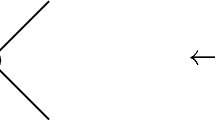Abstract
The monopole-dimer model introduced recently is an exactly solvable signed generalisation of the dimer model. We show that the partition function of the monopole-dimer model on a graph invariant under a fixed-point free involution is a perfect square. We give a combinatorial interpretation of the square root of the partition function for such graphs in terms of a monopole-dimer model on a new kind of graph with two types of edges which we call a dicot. The partition function of the latter can be written as a determinant, this time of a complex adjacency matrix. This formulation generalises Wu’s assignment of imaginary orientation for the grid graph to planar dicots. As an application, we compute the partition function for a family of non-planar dicots with positive weights.







Similar content being viewed by others
Notes
Short for dicotyledons, a plant whose embryo contains two leaves.
References
Arvind Ayyer. Determinants and perfect matchings. Journal of Combinatorial Theory, Series A, 120(1):304–314, 2013.
Arvind Ayyer. A statistical model of current loops and magnetic monopoles. Mathematical Physics, Analysis and Geometry, 18(1):1–19, 2015.
Mihai Ciucu. Enumeration of perfect matchings in graphs with reflective symmetry. J. Combin. Theory Ser. A, 77(1):67–97, 1997.
Alessandro Giuliani, Ian Jauslin, and Elliott H. Lieb. A Pfaffian formula for monomer–dimer partition functions. Journal of Statistical Physics, 163(2):211–238, 2016.
V. E. Hoggatt, Jr. and Marjorie Bicknell. Roots of Fibonacci polynomials. Fibonacci Quart., 11(3):271–274, 1973.
William Jockusch. Perfect matchings and perfect squares. Journal of Combinatorial Theory, Series A, 67(1):100 – 115, 1994.
Pieter W Kasteleyn. The statistics of dimers on a lattice: I. the number of dimer arrangements on a quadratic lattice. Physica, 27(12):1209–1225, 1961.
Richard Kenyon. Local statistics of lattice dimers. Ann. Inst. H. Poincaré Probab. Statist., 33(5):591–618, 1997.
William F. Trench. On the eigenvalue problem for Toeplitz band matrices. Linear Algebra Appl., 64:199–214, 1985.
Tai Tsun Wu. Dimers on rectangular lattices. Journal of Mathematical Physics, 3:1265, 1962.
Acknowledgements
We thank Jeremie Bouttier for discussions and anonymous referees for many useful comments. This work is supported in part by the UGC Centre for Advanced Studies and by Department of Science and Technology Grants DST/INT/SWD/VR/P-01/2014 and EMR/2016/006624.
Author information
Authors and Affiliations
Corresponding author
Additional information
Publisher's Note
Springer Nature remains neutral with regard to jurisdictional claims in published maps and institutional affiliations.
Rights and permissions
About this article
Cite this article
Ayyer, A. Squareness for the Monopole-Dimer Model. Ann. Comb. 24, 237–255 (2020). https://doi.org/10.1007/s00026-019-00480-5
Received:
Accepted:
Published:
Issue Date:
DOI: https://doi.org/10.1007/s00026-019-00480-5
Keywords
- Monopole-dimer model
- Dicots
- Dimer model
- Determinantal formula
- Kasteleyn orientation
- Partition function
- Free energy




